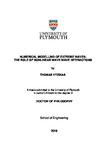Numerical Modelling of Extreme Waves: The Role of Nonlinear Wave-Wave Interactions
| dc.contributor.supervisor | Deborah, Greaves | |
| dc.contributor.author | Vyzikas, Thomas | |
| dc.contributor.other | School of Engineering, Computing and Mathematics | en_US |
| dc.date.accessioned | 2019-04-05T08:12:04Z | |
| dc.date.issued | 2018 | |
| dc.date.issued | 2018 | |
| dc.identifier | 10441171 | en_US |
| dc.identifier.uri | http://hdl.handle.net/10026.1/13660 | |
| dc.description.abstract |
The real monsters of the ocean, extreme waves, haunted mariners since the early days of human activities in the sea. Despite having caused numerous accidents and casualties, their systematic study began only in 2000s. Many mechanisms have been proposed to simulate these rare but catastrophic events, with the most prominent being wave focusing. This is connected to the NewWave theory, which has been used extensively in experimental and numerical modelling. However, the majority of the studies fail to capture the distinguishing characteristics of extreme waves, due to the inherent high nonlinearity of the problem and shortcomings of the modelling practice, but also due to inadequate knowledge of the underlying physics. Overcoming these issues is unquestionably necessary for understanding extreme waves and including them in the engineering design practice. The nonlinearity of the problem lies upon the nonlinear wave-wave interactions, which violate the fundamental linear assumptions of NewWave and pose challenges to numerical models. The present work aims at contributing in both understanding the nature of nonlinear wave-wave interactions during the formation of extreme wave events, and examining the applicability and performance of numerical solvers via their systematic validation with state-of-the-art techniques that give new insights into the problem. A range of phase-resolving and phase-averaged models are employed to cover different scales and examine the undergoing physical processes. Through the study of limiting breaking unidirectional dispersive wave groups in finite water depth, it is demonstrated that the free-wave spectrum undergoes considerable transformation and a large portion of energy is transferred to higher and lower harmonics. These effects can be attributed to the action of near-resonant and bound nonlinearities, which have however robust mathematical description. As such, a large part of the thesis is devoted to analytical methods towards establishing an efficient integrated framework for estimating extreme wave profiles, going beyond the classic NewWave. Overall, the present work is a balance of physics and numerics to tackle parts of the challenging problem of extreme waves and improve safety at sea. | en_US |
| dc.language.iso | en | |
| dc.publisher | University of Plymouth | |
| dc.rights | Attribution-NonCommercial-ShareAlike 3.0 United States | * |
| dc.rights.uri | http://creativecommons.org/licenses/by-nc-sa/3.0/us/ | * |
| dc.subject | Extreme waves | en_US |
| dc.subject | Focused waves | en_US |
| dc.subject | Rogue waves | en_US |
| dc.subject | Numerical Modelling | en_US |
| dc.subject | CFD, Computational Fluid Dynamics | en_US |
| dc.subject | Computational Fluid Dynamics (CFD) | en_US |
| dc.subject | Spectral evolution | en_US |
| dc.subject | High-order spectral method (HOS) | en_US |
| dc.subject | OpenFOAM | en_US |
| dc.subject | Wave profile | en_US |
| dc.subject | Analytical methods | en_US |
| dc.subject | Marine Renewable Energy | en_US |
| dc.subject | Spectral modelling | en_US |
| dc.subject | Harmonic analysis | en_US |
| dc.subject | Focusing methodology | en_US |
| dc.subject | Harmonic decomposition | en_US |
| dc.subject | SWASH | en_US |
| dc.subject | NewWave theory | en_US |
| dc.subject | General Kinetic Equation | en_US |
| dc.subject | Bound waves | en_US |
| dc.subject | Free waves | en_US |
| dc.subject | Validation | en_US |
| dc.subject | Experimental results | en_US |
| dc.subject.classification | PhD | en_US |
| dc.title | Numerical Modelling of Extreme Waves: The Role of Nonlinear Wave-Wave Interactions | en_US |
| dc.type | Thesis | |
| plymouth.version | publishable | en_US |
| dc.identifier.doi | http://dx.doi.org/10.24382/987 | |
| dc.rights.embargodate | 2020-04-05T08:12:04Z | |
| dc.rights.embargoperiod | 12 months | en_US |
| dc.type.qualification | Doctorate | en_US |
| rioxxterms.version | NA | |
| plymouth.orcid.id | https://orcid.org/0000-0001-6576-0527 | en_US |
Files in this item
This item appears in the following Collection(s)
-
01 Research Theses Main Collection
Research Theses Main



